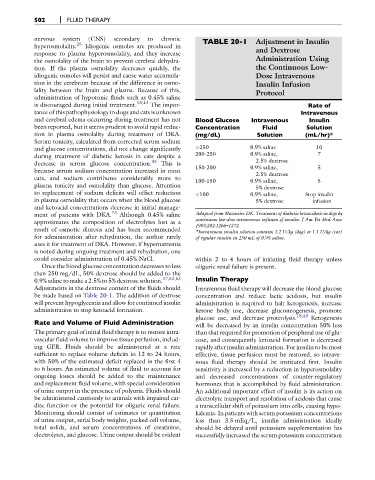Page 514 - Fluid, Electrolyte, and Acid-Base Disorders in Small Animal Practice
P. 514
502 FLUID THERAPY
nervous system (CNS) secondary to chronic TABLE 20-1 Adjustment in Insulin
hyperosmolality. 25 Idiogenic osmoles are produced in and Dextrose
response to plasma hyperosmolality, and they increase
the osmolality of the brain to prevent cerebral dehydra- Administration Using
tion. If the plasma osmolality decreases quickly, the the Continuous Low-
idiogenic osmoles will persist and cause water accumula- Dose Intravenous
tion in the cerebrum because of the difference in osmo- Insulin Infusion
lality between the brain and plasma. Because of this, Protocol
administration of hypotonic fluids such as 0.45% saline
is discouraged during initial treatment. 18,43 The impor- Rate of
tance of this pathophysiology in dogs and cats is unknown Intravenous
and cerebral edema occurring during treatment has not Blood Glucose Intravenous Insulin
been reported, but it seems prudent to avoid rapid reduc- Concentration Fluid Solution
tion in plasma osmolality during treatment of DKA. (mg/dL) Solution (mL/hr)*
Serum tonicity, calculated from corrected serum sodium
and glucose concentrations, did not change significantly >250 0.9% saline 10
during treatment of diabetic ketosis in cats despite a 200-250 0.9% saline, 7
decrease in serum glucose concentration. 45 This is 2.5% dextrose
150-200 0.9% saline, 5
because serum sodium concentration increased in most
2.5% dextrose
cats, and sodium contributes considerably more to
100-150 0.9% saline, 5
plasma tonicity and osmolality than glucose. Attention 5% dextrose
to replacement of sodium deficits will offset reduction <100 0.9% saline, Stop insulin
in plasma osmolality that occurs when the blood glucose 5% dextrose infusion
and ketoacid concentrations decrease in initial manage-
ment of patients with DKA. 73 Although 0.45% saline Adapted from Macintire DK. Treatment of diabetic ketoacidosis in dogs by
approximates the composition of electrolytes lost as a continuous low-dose intravenous infusion of insulin. J Am Vet Med Assoc
1993;202:1266–1272.
result of osmotic diuresis and has been recommended
*Intravenous insulin solution contains 2.2 U/kg (dog) or 1.1 U/kg (cat)
for administration after rehydration, the author rarely of regular insulin in 250 mL of 0.9% saline.
uses it for treatment of DKA. However, if hypernatremia
is noted during ongoing treatment and rehydration, one
could consider administration of 0.45% NaCl. within 2 to 4 hours of initiating fluid therapy unless
Once the blood glucose concentration decreases to less oliguric renal failure is present.
than 250 mg/dL, 50% dextrose should be added to the
0.9% saline to make a 2.5% to 5% dextrose solution. 17,52,53 Insulin Therapy
Adjustments in the dextrose content of the fluids should Intravenous fluid therapy will decrease the blood glucose
be made based on Table 20-1. The addition of dextrose concentration and reduce lactic acidosis, but insulin
will prevent hypoglycemia and allow for continued insulin administration is required to halt ketogenesis, increase
administration to stop ketoacid formation. ketone body use, decrease gluconeogenesis, promote
18,43
glucose use, and decrease proteolysis. Ketogenesis
Rate and Volume of Fluid Administration
will be decreased by an insulin concentration 50% less
The primary goal of initial fluid therapy is to restore intra- than that required for promotion of peripheral use of glu-
vascular fluid volume to improve tissue perfusion, includ- cose, and consequently ketoacid formation is decreased
ing GFR. Fluids should be administered at a rate rapidly after insulin administration. For insulin to be most
sufficient to replace volume deficits in 12 to 24 hours, effective, tissue perfusion must be restored, so intrave-
with 50% of the estimated deficit replaced in the first 4 nous fluid therapy should be instituted first. Insulin
to 6 hours. An estimated volume of fluid to account for sensitivity is increased by a reduction in hyperosmolality
ongoing losses should be added to the maintenance and decreased concentrations of counter-regulatory
and replacement fluid volume, with special consideration hormones that is accomplished by fluid administration.
of urine output in the presence of polyuria. Fluids should An additional important effect of insulin is its action on
be administered cautiously to animals with impaired car- electrolyte transport and resolution of acidosis that cause
diac function or the potential for oliguric renal failure. a transcellular shift of potassium into cells, causing hypo-
Monitoring should consist of estimates or quantitation kalemia. In patients with serum potassium concentrations
of urine output, serial body weights, packed cell volume, less than 3.5 mEq/L, insulin administration ideally
total solids, and serum concentrations of creatinine, should be delayed until potassium supplementation has
electrolytes, and glucose. Urine output should be evident successfully increased the serum potassium concentration

